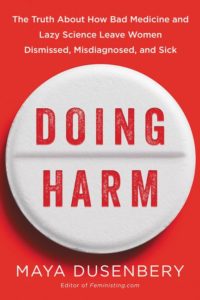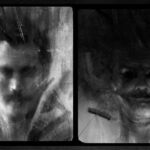Regarding the Pain of Women
Why American Medicine Needs a More Nuanced Approach to Chronic Pain
When Alexis was 11, her hips began to hurt. The pain felt as if it was deep in her bone and would radiate to her lower back and to the front to her pelvis. Her mother took her to doctor after doctor. She got X-rays and ultrasounds, and saw spine and arthritis specialists. But they could find no cause for her pain.
We’ve seen how the distrust of women’s reports of pain and other subjective symptoms leads to delayed diagnoses and under-treatment for a range of conditions, from heart attacks to lupus to appendicitis. But perhaps the most long-lasting impact of this bias has been on those like Alexis, who suffer from unexplained chronic pain, in which the objective evidence to confirm women’s subjective and ever-suspect reports is simply never found.
As her pain became more and more debilitating over the next several years, Alexis eventually gave up on finding a diagnosis and instead searched for a doctor who would at least take her pain seriously and help her figure out how to better manage it. Even that was elusive. “I just felt like no one ever believed me. I never could find anyone to help me—ever. And I saw a lot of doctors, for a long time.”
*
In 2011, the IOM released an influential report entitled Relieving Pain in America that offered an alarming indictment of the medical system’s treatment of pain. “On the one hand, pain is extremely widespread in American society, exacts a huge toll in suffering and disability, and imposes extraordinary costs on the health care system and the nation’s economy,” the IOM experts wrote. “On the other hand, all too often treatment is delayed, disorganized, inaccessible, or ineffective.” While the report found evidence of inadequate treatment of acute pain (for example, from an injury treated in the ER or in postoperative care after a surgery) the IOM was especially concerned about the large burden, on both patients and the health care system, posed by chronic pain. Chronic pain is generally defined as pain that lasts more than three to six months or persists past the point of normal healing.
By the IOM’s new estimate, roughly 40 percent of the population live with chronic pain. That’s 100 million Americans, which is more than the number affected by diabetes, heart disease, and cancer combined, and their ranks have been growing in recent decades. Chronic pain is, quite simply, “the most prevalent human health problem” and the leading cause of long-term disability. The IOM estimated that chronic pain costs the nation $560 billion to $635 billion in health care costs and lost productivity each year.
Yet in recent years, the NIH has devoted a minuscule $400 million a year—about 1 percent of its annual budget—to studying chronic pain. That’s a mere 5 percent of what goes to studying diabetes, heart disease, and cancer combined. According to a recent study of 117 medical schools, only four schools in the United States offer a required separate course on pain. Students received, on average, 11 hours of instruction on the subject. Unsurprisingly, given this minimal training, a national survey found that almost 30 percent of primary care residents, who are on the front lines when it comes to treating pain, said they felt unprepared to help patients with pain management. And the 3,000 to 4,000 pain specialists nationwide aren’t nearly enough to meet the huge need for their expertise.
The majority of the 100 million Americans who live with chronic pain are women. In surveys that ask respondents whether they’ve had pain in different parts of the body over the last several months, greater proportions of women report pain. It’s a finding that’s fairly consistent across different populations: a 2008 study of tens of thousands of patients in over a dozen countries found that the prevalence of any chronic pain condition was 45 percent among women, compared to 31 percent among men.
Many of the most prevalent chronic pain conditions, such as osteoarthritis (OA), which affects over 30 million Americans, chronic low back pain (nearly 20 million), IBS (44 million), and migraine (36 million), are more common among women. Women are twice as likely to have autoimmune diseases, many of which bring with them persistent pain. Women are up to four times more likely to experience the bladder pain of interstitial cystitis (IC), the jaw pain of temporomandibular disorders (TMD), and the widespread, full-body pain of fibromyalgia. And some common chronic pain conditions almost exclusively affect women: vulvodynia, which causes pain around the vaginal opening, and endometriosis, which causes pelvic pain associated with menstruation.
“Chronic pain is, quite simply, ‘the most prevalent human health problem’ and the leading cause of long-term disability.”
Over the last few decades, there has been a paradigm shift in our understanding of chronic pain. Historically, and especially since the 20th century, medicine has considered pain to be a symptom of disease, one to be alleviated as much as possible, to be sure, but clinically relevant primarily as a clue pointing toward the underlying problem. “Cure the disease, and cure the pain” has been the assumption. While this principle may hold true of acute pain, in many cases, according to the International Association for the Study of Pain, “chronic pain is a disease in its own right.”
“This profound recasting,” the IOM report declared, “means that pain requires direct, appropriate treatment rather than being sidelined while clinicians attempt to identify some underlying condition that may have caused it. Prompt treatment can derail the progression of pain from the acute to the chronic state. This recasting also means that health professions education programs should include a substantial amount of learning about pain and its diversity, and that people with chronic pain should be recognized by family, employers, health insurers, and others as having a serious disease.”
What is Pain Anyway?
To understand what it means to say that chronic pain is a disease in its own right, it’s important to realize that pain is usually vitally important. These days, pain experts generally classify pain into four different types. The kind we’re most familiar with from our daily lives is nociceptive pain, which we feel in response to any noxious stimulus (something too sharp, hot, cold) that could hurt us. Usually acute, it’s considered adaptive—that is, it’s actually very helpful. It’s supposed to feel terrible when you touch the handle of a hot pan, for example, because it alerts you that you could get burned. To see just how protective this type of pain is, imagine how risky—and short—life is for people who, due to a rare genetic defect, can’t feel pain at all: with nothing telling them it is dangerously hot, they don’t let go of the pan.
If a noxious stimulus is able to do some real damage to your tissue, inflammatory pain kicks in as your immune system is activated to repair it. After the initial nociceptive pain signaling you’ve burned yourself on that hot pan, low-grade inflammatory pain lingers, keeping your hand more sensitive than usual until the wound is fully healed. Like nociceptive pain, inflammatory pain is relatively acute and protective; its purpose is to keep you from further injuring yourself while your body is still vulnerable, and, if all goes as it should, it will stop once mending is complete.
Some conditions that cause chronic pain involve nociceptive or inflammatory pain. And in such cases, the pain, though chronic, is still serving its useful purpose as a warning sign of an underlying problem. For example, in RA, pain in the joints is an expected consequence of the immune system mobilizing against the joint lining; though the autoimmune attack is abnormal, the inflammatory pain it causes is normal. In OA, in which the protective cartilage cushion between bones is eroded, the pain is considered nociceptive.
But a great deal of chronic pain is pathological. It does not seem to be a symptom indicating tissue damage or inflammation: there is no apparent reason for the pain, and that is itself the problem. Harvard neurobiologist Dr. Clifford J. Woolf, director of the F.M. Kirby Neurobiology Center at Boston Children’s Hospital, offers this analogy to explain the difference: “If pain were a fire alarm, the nociceptive type would be activated appropriately only by the presence of intense heat, inflammatory pain would be activated by warm temperatures, and pathological pain would be a false alarm caused by malfunction of the system itself.” Pathological pain comes in two flavors: In neuropathic pain, the malfunction seems to be triggered by damage to the nervous system itself. And then there is dysfunctional pain (also known, confusingly, as functional pain), in which there’s pain in the absence of any injury, inflammation, or nerve lesion to explain it at all.
It’s only in the last couple of decades that this way of classifying pain has become accepted. Previously, there were really only two types of pain: “organic” pain that was due to some underlying disease and “medically unexplained” pain that was assumed to be psychogenic. Pathological, particularly functional, pain just didn’t fit into the early models of what pain is. In the 17th century, philosopher René Descartes imagined the pain-perception pathway as a cord running from our nerve endings to our brain; the pain of a hammer striking your hand, in his example, would pull on the cord and cause a bell located in the brain to ring: the message of pain received. This basic idea stuck around for centuries.
Still, in the 1800s, as the discovery of opiates and anesthesia revolutionized the treatment of acute and surgical pain, doctors regularly encountered patients with chronic pain who didn’t fit into this model, who had pain in the absence of anything that seemed to be ringing the bell. For the most part, 19th-century physicians believed the reports of patients with this kind of “pain without lesion.” With their Cartesian bent, they considered pain without lesion to be an impossibility, but, with a healthy sense of humility, they generally assumed that the lesions that explained their patients’ mysterious suffering simply hadn’t been uncovered yet.
“A great deal of chronic pain is pathological. It does not seem to be a symptom indicating tissue damage or inflammation: there is no apparent reason for the pain, and that is itself the problem.”
Post-Freud, however, psychiatry was offering alternative theories for what ailed such patients, and physiological evidence was emerging that seemed to support the theory that there was a straightforward, proportional relationship between a noxious stimulus and the pain it caused. Once this idea—the specificity theory of pain—took firm hold in American medical schools in the early 20th century, pain that wasn’t explained by an organic pathology came to be seen as hysterical—if the patient’s complaint was believed at all. “Those who suffered from unexplained chronic pain syndromes were often regarded as deluded or were condemned as malingerers or drug abusers,” writes historian Marcia L. Meldrum.
In the 1960s, the gate control theory of pain complicated the simple, cause-and-effect Cartesian model somewhat by positing that not all pain signals sent from the peripheral nerves make it to the brain; they encounter “nerve gates” in the spine that either allow them through or block them. An important step forward, it better accounted for the fact that the relationship between injury and pain isn’t very consistent at all; a minor injury can cause great pain in one person, while a major one is barely felt by another. And it helped explain how the perception of pain is influenced by thoughts and emotions—for example, why it seems to hurt worse when you stub your toe just after receiving some bad news. Although this new model recognized that the central nervous system (the spine and brain) played a role in modulating pain, it still held that there had to be something causing the peripheral nerves to fire off their pain signals.
That continued to leave only two options for explaining the mystery of “pain without lesion”: either there was pathology affecting the peripheral nerves that had thus far eluded medicine’s current tools of perception, or there wasn’t, in which case such pain could be labeled “medically unexplained” and, by default, “psychogenic.” Lacking the humility of their 19th-century predecessors, most in the profession went with the latter option. Chronic pain that wasn’t a symptom of an observable organic problem was generally assumed to be caused by psychological factors—though the exact mechanism by which this happened was always left hazy—and categorized as a pain disorder in the somatoform section of the DSM. In fact, any pain that seemed to be in “excess” of what would be expected given the extent of tissue damage was blamed on the patient’s “emotional overlay.”
As Dr. Daniel Clauw, director of the Chronic Pain and Fatigue Research Center at the University of Michigan, explains, a couple of decades ago, “if you went to a doctor with chronic pain in any particular region of the body and they couldn’t find anything wrong in that area of the body, they would have a tendency to then blame the patient: ‘there’s nothing wrong with you, you’re stressed, it’s a psychiatric problem.’ ” They’d offer “any misattribution for those symptoms” rather than cop to the basic truth: “that we just don’t understand pain well enough yet.” It was “very frustrating for the patients because they knew in their heart that that was not the nature of their problem.”
This duality between organic and psychogenic pain was reflected in the tests the doctors gave Alexis as she searched for an explanation for her pain as a teen in the late 90s. “They would say, ‘We’ll do this imaging, and then we’ll do this questionnaire.’ ” The questionnaire was a psychological test to determine whether she was suffering from depression, anxiety, bipolar disorder, or another mental health problem. “Nothing ever came back on imaging or on the psychological stuff.”
Of course, the convenient thing about psychogenic symptoms is that the patient doesn’t actually have to demonstrate any psychological disorder at all to have them. So, faced with pain they didn’t understand, doctors would frequently suggest that Alexis’s condition was psychogenic despite her normal psychological scores. Sometimes, since it was in the general vicinity of her uterus, her pain would be vaguely attributed to “female problems”—menstrual cramps or a “hormonal imbalance.” Often doctors would simply say, “Well, we don’t see anything wrong: you’re fine,” she recalls. “Well, I’m not fine; I’m in a lot of pain.”
__________________________________

From Doing Harm: The Truth About How Bad Medicine and Lazy Science Leave Women Dismissed, Misdiagnosed, and Sick. Used with permission of HarperOne, an imprint of HarperCollins Publishers. Copyright © 2018 by Maya Dusenbery.




















